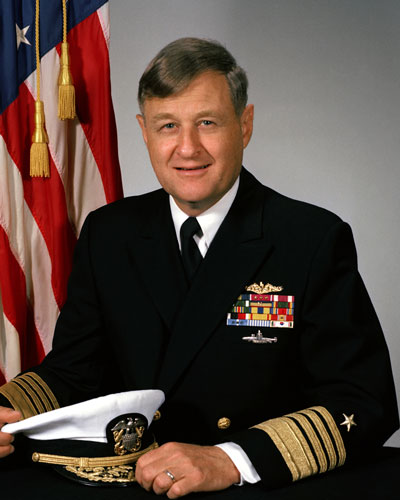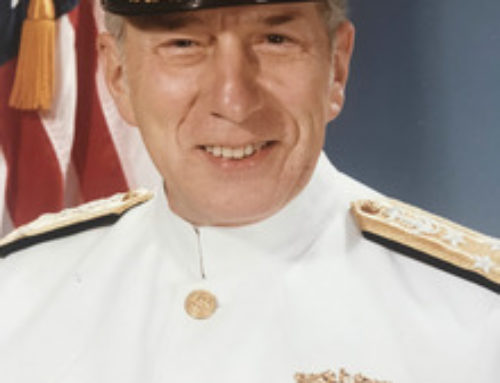Steven Angelo White was born on September 18, 1928 in Los Angeles, California, growing up primarily in Tujunga, California. After graduating early from Verdugo Hills High School in 1946, he received a scholarship to Occidental College. After a brief stay at Occidental, he would transfer to the University of Southern California, under a full Naval ROTC scholarship.
After completing his education, White attempted to enlist during World War II, but was turned down due to his age. In 1948, he joined the United States Navy Reserve as an enlisted seaman. Through his ROTC scholarship at USC, he began his career as a naval officer. While at USC, he earned his BA in International Relations, while simultaneously working towards his Masters in Political Science. He would also begin work on a Law Degree, which he would not complete due to his progressing naval career and family.
Following his graduation from USC in the summer of 1952, White was commissioned as an ensign. His first assignment as a commissioned officer was aboard USS Manchester, during the ship’s service in the Korean War. He would serve aboard her through the conclusion of the war on July 27, 1953.
At the end of that year, he was accepted into the submarine program as a newly promoted LTJG. The White family would travel to Groton, CT where Steve would attend submarine training. After successful completion of his training, he received orders to USS TANG (SS-563), upon which he would serve two years, including a lengthy trip to Japan. Upon his return, White seriously contemplated resigning from the Navy to continue his pursuit of a Law Degree. Before he could decide he had a chance encounter with “Father of the Nuclear Navy”— ADM Hyman G. Rickover, whose Naval nuclear program was just gaining steam.
White’s first encounter with Rickover, which consisted of attendance to a lecture given by Rickover in Pearl Harbor in 1956, inspired Steve to apply for one of the very few openings in Rickover’s program. He survived the near-legendary and grueling interview process and, accepted to the program, once again relocated his family to New London to attend the Naval Nuclear Power School in the Naval Submarine Base from June 1956 through December 1956. Following graduation, the Whites moved to Idaho where Steve could continue his training at the nuclear prototype reactor in Arco.
Steve’s first assignment post-training was aboard USS Nautilus (SSN-571), Admiral Rickover’s first nuclear submarine. From the clear May day in 1957 when Steve first climbed aboard Nautilus until he left the ship in mid-1960, Steve’s experience and love for that ship grew at an exponential rate. From September 1957 through May 1958, Nautilus made her first attempt to break into the “no man’s land” of the Arctic. Her introduction to the forbidding waters of the Arctic was certainly eventful. A first foray—part of a training rendezvous with the diesel sub USS Trigger at the southern end of the icepack, to be followed by participation in “Operation Strikeback”, a series of NATO exercises in the North Atlantic—demonstrated to both officers and crew the intensity of the challenge posed by the comparatively uncharted and unpredictable waters under the icepack. Their initial attempt to make a “run” for the Pole during their training with Trigger in early September was unsuccessful, owing to the unpredictability of the underwater ice. Nautilus successfully completed a transpolar crossing during “Operation Sunshine”, piercing the pole on 3 August, 1958. This achievement was announced by the legendary message: “Nautilus Ninety North.” After this amazing achievement, Nautilus would undergo her first overhaul, during which time White would serve as PR representatives for Nautilus and the naval nuclear power program.
After leaving his beloved Nautilus, Steve would go to Bettis Atomic Power Lab in West Mifflin, Pennsylvania. He would then go on to serve as Engineer of the USS Ethan Allen, which had the distinct honor of carrying out the only ordered complete missile test with an armed warhead. Shortly after White was promoted to Executive Officer of Ethan Allen, upon which he would experience the 1962 tension s of the Cuban Missile Crisis.
By 1969, White was ordered to serve as Commander of Division 102, supervising four submarines. This assignment was followed by working for Rickover’s Naval Reactors, where he received the billet of Commander of the navy’s second Fleet Ballistic Missile (FBM) Submarine Squadron in Rota, Spain. He would be promoted to Rear Admiral at the conclusion of his tour to Spain, where he would serve as commander of Submarine Group Two in Groton, CT.
At his next assignment at the Office of Naval Material (NAVMAT), White would reform the branch and establish a cohesive group of material personnel that would function seamlessly and efficiently. This assignment was followed by a trip to the Deputy Chief of Naval Operations (OP-02) in 1978, where he would be in charge of Submarine Warfare. In May 1980, White was promoted to Admiral three stars and sent to serve as COMSUBLANT.
During his tenure at COMSUBLANT, he created the Tactical Readiness Evaluation program (TRE), reconstructed war plans for interactions with the Soviet Union, and transformed the program for negotiating the pace of operation and calculating “home port” time for officers and crew.
In May 1983, White received his fourth star and a final naval assignment as Chief of NAVMAT.
ADM White retired from the Navy in July 1985, after which he worked as a part-time contractor and advisor for various companies. He would accept a position at the nuclear power division of the Tennessee Valley Authority (TVA). After retiring from the TVA in 1988, he would work for Lockheed Martin Corporation and EBASCO as a contractor.
ADM White was married to his wife, Mary Anne (Landreau) for seventy years. Together they had seven children, thirty-five grandchildren, seven grandchildren-in-law, and eleven great-grandchildren.
Information for this article was garnered from MilitaryWiki.




